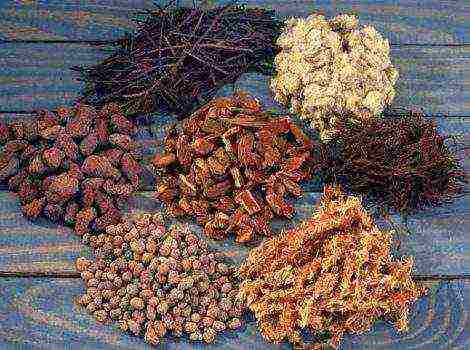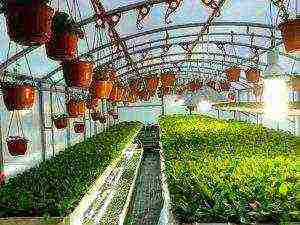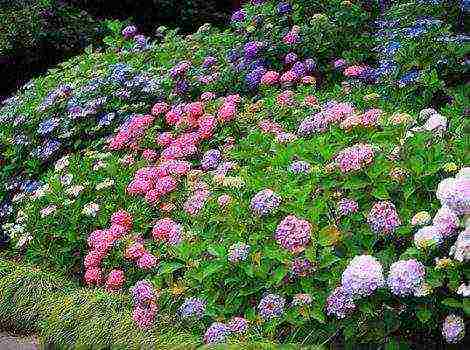Content
- 1 Growing strawberries all year round - myth or reality?
- 2 Preparatory stage
- 3 Growing technology
- 4 Planting care
- 5 Growing strawberries in a greenhouse (video)
- 6 Site preparation for growing
- 7 Planting strawberry bushes
- 8 Winter planting care
- 9 Dutch technology
- 10 Secrets of the winter harvest
- 11 Conclusion
- 12 Equipment for growing strawberries
- 13 Greenhouse strawberry varieties
- 14 Methods for growing strawberries in a greenhouse
- 15 Care for strawberries in the greenhouse
Strawberries are a fully-fledged and universally recognized berry queen. Its taste and aroma are loved by both adults and children. Unfortunately, it is quite difficult to eat fresh strawberries during the cold season. You can provide yourself with it in the winter thanks to growing berries in a greenhouse.
Growing strawberries all year round - myth or reality?
Almost every owner of a summer cottage has at least a small garden with strawberries. This is usually enough to pamper yourself with fresh berries and even provide the family with jam and compote for the winter. But you want delicacies not only in summer, but also in the cold season.
The climate of the southern regions allows for several harvests per year. Things are much more complicated in the north and in the middle lane.
Of course, you can buy strawberries from the store if necessary. But, firstly, in winter this berry is very expensive, and secondly, many are alarmed by the methods of growing in artificial conditions using growth stimulants and GMOs.
There is only one way out: start growing strawberries on your own. So you can provide seven berries, and even build a profitable business on this. But how real is it?
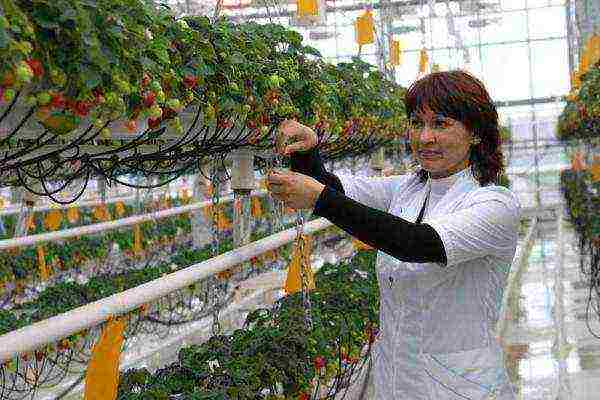
Growing strawberries in a greenhouse is possible in mid and northern latitudes
Until recently, one could say that this is impossible at home. But nowadays, when industrial technologies become available to private consumers, everyone can grow strawberries all year round. A good greenhouse, built and equipped according to the rules, will help with this. The main thing to ensure is:
- heating;
- lighting;
- irrigation.
In addition, it is necessary to select suitable strawberry varieties, prepare the soil, and in the future, do not forget about proper berry care. And if you can easily cope with these requirements on your own, then it is better to entrust the construction and equipment of the greenhouse to professionals.
Remember that growing strawberries all year round is not easy and costly. If you want to "recoup" the invested funds and efforts, you will have to work a lot.
Preparatory stage
Greenhouse
Note! The main advantage of growing strawberries in a greenhouse, compared to open ground, is the absence of seasonal restrictions.
You can build a greenhouse in your garden by defining a plot for it, the soil on which is best suited for composition. There are 3 main types of structures of this kind.
- The most affordable option is a wooden frame with a film coating. The design is short-lived; the film will have to be replaced with a new one every season.In addition, in a harsh winter, such a coating is not considered reliable.
- A steel profile as a supporting structure, covered with cellular polycarbonate - such a greenhouse is lightweight, but strong at the same time. The cost is higher than the first option.
- Glass covering on a steel frame is the most durable, reliable and durable structure. Ideal for creating the necessary conditions inside.
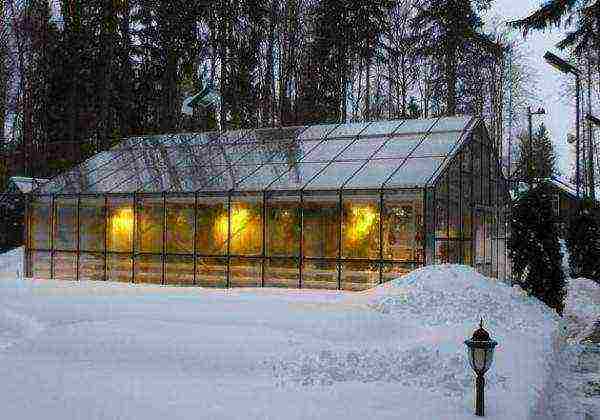
Installing a greenhouse from quality materials and its equipment is the first step to large yields
Organization of temperature and humidity conditions
In order for the strawberries to grow normally in the greenhouse, it is necessary to provide a gentle increase in the air temperature. In cool conditions, this culture significantly slows down the flowering process. In addition, the moisture level is very important.
For example, after planting seedlings, it is necessary to maintain humidity within 80%, reducing the level by 5% during the flowering period, and by another 5% during the formation of the fruit.
Strawberry is a thermophilic plant for which temperature is very important.
- During disembarkation, the optimum temperature is + 10 ° C.
- Gradually raise the reading to + 20 ° C as it grows.
- When the strawberries begin to bloom, keep the temperature between +20 and + 24 ° C.
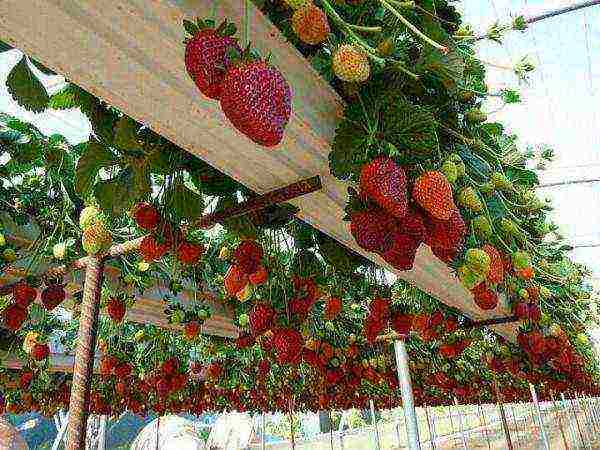
For strawberries in the greenhouse, you need to provide moisture, light and warmth.
Note! Prolonged exposure to too high a temperature will lead to the growth of a large number of leaves, which significantly shade the useful area of the plant. Accordingly, flowering and fruiting may deteriorate.
Light mode
There are strawberry varieties with neutral daylight hours (allowing low light levels). But even they need light, especially during the flowering period. The duration of flowering and fruiting depends on the intensity of illumination.
For example, with an 8-hour day, flowering occurs in 14 days, and the ovary appears 1.5 months after planting. By increasing the daylight hours to 16 hours, you can achieve flowering in 10 days, and ovaries in 35–37 days.
Equipment
In order to ensure the normal level of light, humidity and temperature in the greenhouse, especially in winter, you will need special equipment.
To maintain a normal humidity level, it is enough to spray the greenhouse with spray guns or sprinklers. At the same time, avoid getting water on the leaves and flowers of the plant.Excessive watering will also not be beneficial: strawberries may die from an excess of moisture. To avoid this, install a drip irrigation system for greenhouses.
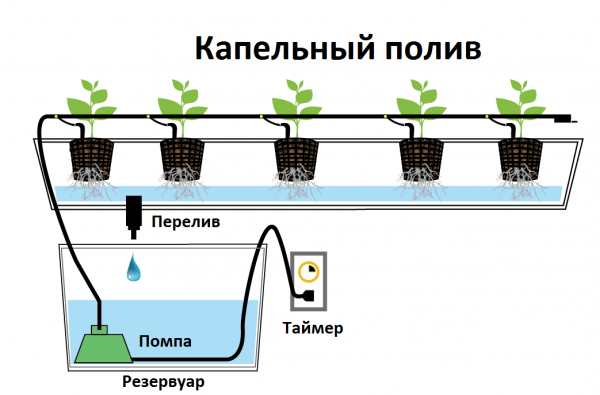
Drip irrigation system will avoid excess moisture
More modern models will provide not only the supply of the soil with liquid, but also the regulation of the humidity level in the room.
When choosing such a system, pay attention to the area of the territory occupied by a greenhouse with strawberries.Water consumption for irrigation should be adjusted at the rate of 3 liters per day per 1 m of the length of the garden bed or container.
Such a system can be made with your own hands from improvised means.
- Install a barrel or other container for liquid of the required volume 0.5 m above the level of the beds.
- Attach a long hose to it, run it along the bottom of the strawberry containers (or in the recess in the middle of the garden), and make a plug at the end.
- Make small holes along the entire length of the hose at a distance of 3-5 cm: water will flow into the ground through them.
For the autumn-winter period, the greenhouse must be provided with additional lighting. In addition to the fact that daylight hours are significantly reduced, and the sun is often hidden behind clouds, greenhouses used in the cold season usually have design features that create high shading. To deal with this, install high pressure sodium lamps.
In such lighting devices, the intensity of radiation is as close as possible to sunlight in the summer.Choose 400W lamps for your greenhouse.

It is very important to choose and install lighting fixtures correctly.
They need to be placed at a height of 1 m above the strawberry garden. Calculate the required number of devices based on the fact that for 3 square meters. m. there should be 1 lamp.
For example, if you have a rack or bed 10 m long and 1 m wide, then you should use 4 sodium lamps.
With regard to heating, the best option would be to connect the greenhouse to an indoor heating system.
Suitable varieties
If you want to get a high-quality harvest, then you need to choose berry varieties according to at least two criteria.
- Optimal climatic conditions for strawberries. In this case, you need to pay attention to the weather conditions inherent in your lane. We recommend purchasing seedlings from nurseries located in your region. This will allow you to get an already acclimatized strawberry.
- Ripening terms.The ideal option would be organization of several beds with strawberries of different by the duration of ripening varieties. Thus, you will not only be able to harvest several crops from June to the end of September, but you will also have seedlings on hand for further cultivation in the greenhouse.
In the conditions of the middle zone and colder regions (Ural, Siberia, the Far East), self-pollinated remontant varieties are recognized as optimal for growing in greenhouses. They usually ripen early, which means that the harvest will be good even with a thickened planting. In addition, if these varieties belong to the group of neutral daylight hours, then they do not require long-term intense lighting.
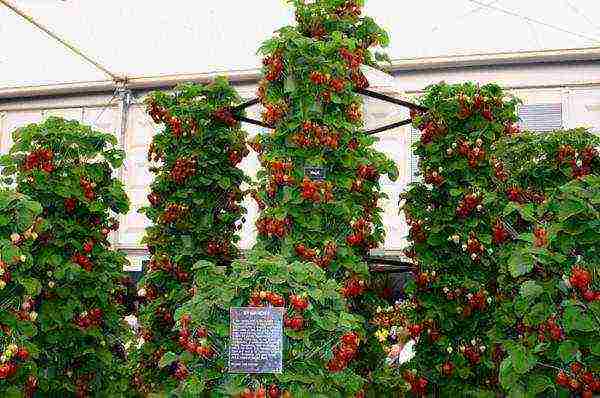
Choose specially bred varieties for greenhouse cultivation
The most popular varieties suitable for growing in our latitudes:
- Pineapple;
- Arapaho;
- Brighton;
- Mount Everest;
- Darselect;
- Elizabeth II;
- Yellow miracle;
- Zenga Zengana;
- Temptation;
- Queen Elizabeth;
- Crown;
- Marmalade;
- Maria;
- Mahern;
- Moscow delicacy;
- Darkness;
- Ozark Beauty;
- Polka;
- Professional;
- Red Rich;
- Sakhalin;
- Selva;
- Sonata;
- Tribute;
- Truffau Producer;
- Tristar;
- Honey;
- Elsanta.
Modern breeding has given us many varieties that are self-pollinating, but with classic varieties, pollination will have to be done manually.
Greenhouse strawberry varieties (gallery)
Preparing the beds
The correct organization of the beds will help you make the most efficient use of the usable area of the greenhouse. In addition, you will provide the strawberry bushes with the necessary nutrition, lighting and irrigation. The best option is considered to be growing not on the ground, but in hanging containers.
For containers, arrange all-welded metal profile bases that can withstand heavy loads. The width of the finished frame should be about 1 meter, the length is equal to the length of the greenhouse, and along the edges there are 2 longitudinal sections for containers 20 cm wide.
The containers themselves can be made from any available materials: plastic, plywood, boards, cellular polycarbonate. Simply insert the assembled containers into the metal frame and fill with the prepared substrate.
Soil preparation
Regular garden soil is not suitable for year-round strawberry cultivation. For continuous fruiting, a highly nutritious environment must be provided. To prepare a substrate in the amount of 1 ton, you will need:
- 300 kg of chicken manure;
- 650 kg of straw (preferably from winter wheat or oats);
- 6 kg of chalk;
- 20 kg of plaster;
- 3 kg of urea.
All components are readily available, you just have to properly compost them. To do this, put in a pile in layers in this order:
- Straw layer 25 cm thick.
- Chicken droppings - 10 cm
- Urea at the rate of 400 grams per 100 kg of straw.
Repeat the layers until a heap is about 1.5 m wide and up to 2 m high. Water each layer well with warm water. In a few days, the fermentation of the components will begin, which will last about a month. During this time, you need to mix the compost, that is, mix it:
- the first time - 10–12 days from the beginning of fermentation;
- the second - after 17 days;
- the third - after 25 days.
To rid the substrate of possible viruses, ticks and aphids, sterilize it. To do this, pour the compost onto a large metal tray, cover and place over low heat. Raise the substrate temperature gradually to 60 °. Keep in this state for at least 12 hours, while strictly controlling the temperature level: exceeding it will turn the substrate into "dead ground".
Seedling preparation
Strawberries are cultivated as an annual plant, so the quality of the planting material is very important. We have already said that it is most convenient to purchase strawberry seedlings of suitable varieties in the nursery. But you can use the berries that grow in your garden in the open field.
- Select bushes for mother plantation in June, after the first strawberries ripen. Mark the bushes on which the berries ripen the fastest. After the harvest is harvested, a mustache will appear. Leave a maximum of 5 outlets on each of the marked bushes, remove the rest.
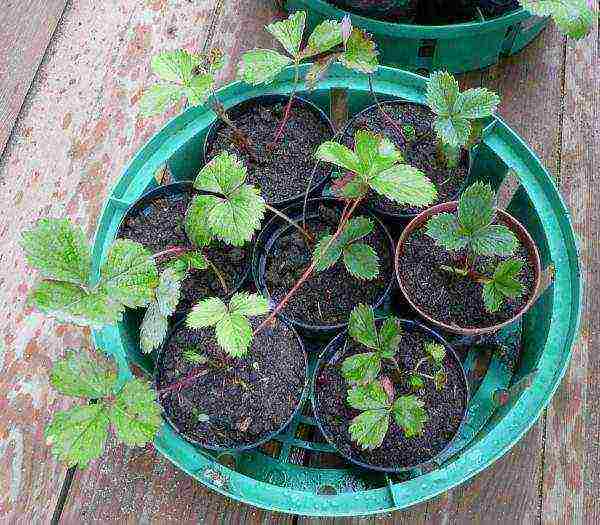
As seedlings, you can use those berries that grow in your garden in the open field.
- Until August, reduce the care of the planting material to regular loosening of the soil. During this time, the strawberry will develop a good root system. Transplant the bushes into a prepared nursery-garden with a fertile substrate according to the 15 X 15 cm pattern. Seedling boxes can be used in the same capacity.
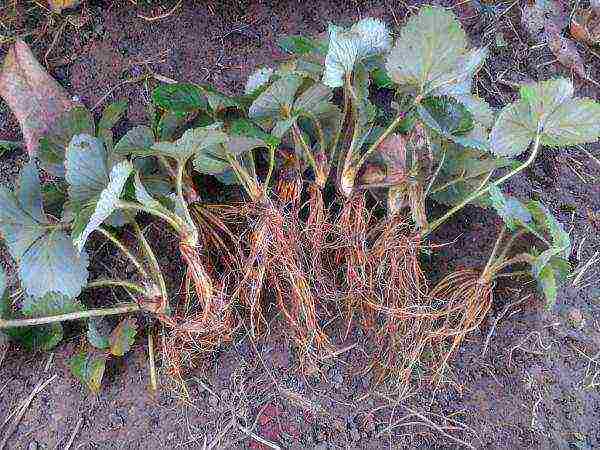
Until August, reduce the care of the planting material to loosening the soil, during which time the strawberries will form a good root system
- At the end of autumn, before frost, transplant the seedlings into pots with nutritious soil, removing all the leaves. Move to a basement or other room where the temperature does not fall below -2 ° C. Store containers with seedlings under these conditions for up to 9 months. Transplant the seedlings into the greenhouse when needed.
Growing technology
Today, the Dutch method of growing strawberries in a greenhouse has gained great popularity. It is simple and affordable, ideal for small areas (you can use it not only in the greenhouse, but even on the balcony), and allows you to get several high yields throughout the year.
The essence of the technology lies in the use of special film sleeves for growing, which are filled with a substrate of perlite and steamed peat. This mixture has a high level of hygroscopicity, that is, it absorbs moisture 4 times more than its own volume, while simultaneously saturating it with useful substances. At the same time, flowers and fruits do not come into contact with the ground, which protects them from decay.
Dutch technology has 2 main options. The choice may depend on the available space in the greenhouse. If desired, the methods can be combined.
- Horizontal placement of bags - the bushes are planted in a checkerboard pattern at a distance of 25-30 cm from each other. The bags are arranged in several levels with a gap of 0.5 meters. The disadvantages of this method include the need to organize lighting: its intensity should be equal for all strawberry bushes.
- Vertical - you can use polymer pipes with cutouts 5–7 cm in diameter. Place them in several rows at a distance of 25–30 cm in height from each other. Fix the structures in an upright position.

Dutch strawberry cultivation technology is recognized as the simplest and most convenient
Planting care
For a good harvest, it is important to properly care for your strawberries. Above, we have already talked about how to maintain light and temperature conditions, as well as humidity in the room used.
- Be sure to provide your greenhouse strawberries with additional lighting for 8-10 hours a day at least from December to early March.
- Remember to gradually increase the temperature in the greenhouse from the moment the buds form.
- Control the humidity in the greenhouse.
- Be sure to provide fertilizing with fertilizers. For example, once every 2 weeks, use the following mixture: for 10 liters of water - 10 g of potassium salt and 80 g of superphosphate with ammonium nitrate.
Pollination
When growing strawberries in greenhouse conditions, pollination will have to be done manually. Alternatively, you can start a small hive with bees or bumblebees, but this is too laborious. Therefore, it is better to arm yourself with a soft brush. You can buy it at any stationery store.
Pollination should be carried out as follows: 2-3 times a day, gently brush over the flower, collecting pollen, and then transfer it to another flower. It is very important that at this time the humidity in the greenhouse is low.
There is a more interesting way. Take a regular household fan and blow a stream of air at the flowers. The pollen from them will scatter and settle on other plants.
Prevention of diseases and pests
The main enemy of strawberries is gray rot. It is very difficult to treat it, it is much easier to prevent its appearance. To do this, control the humidity level in the greenhouse, do not allow it to rise to a critical level.

Apply fungicides during the flowering period of the strawberry until the petals fall off.
Periodically use a fungicide for spraying: it is applied by a drop method to the root zone. This should be done during the flowering period of the strawberry, until the petals fall off.
Heat and humidity often provoke slugs. You can get rid of them with special traps that can be purchased at any hardware store.
Growing strawberries in a greenhouse (video)
Growing strawberries in a greenhouse all year round is a very time consuming task, but such work (with the proper approach) can bring you considerable income. Fresh juicy berries are always in demand among the population. Tell us in the comments about your experience in growing strawberries. Good luck to you!
Good afternoon! My name is Svetlana. This site has become for me not only an additional source of income, but also an opportunity to share my knowledge of housekeeping with you.
Delicate berries amaze everyone with their taste and aroma, one problem - strawberries bear fruit for only a month. Growing strawberries in a greenhouse can help solve this problem. With the right approach, you will enjoy juicy fruits all year round. There is one condition: if you want to be with a rich harvest in winter, don’t spare the money to buy high-quality equipment. In a greenhouse, assembled from scrap materials, at best, you will taste a few stunted berries, although you will spend a lot of work on leaving.
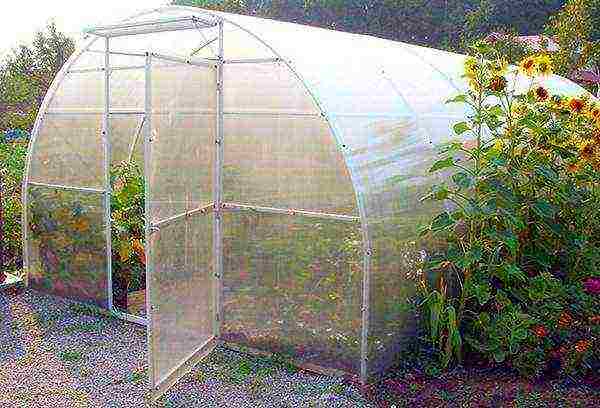
Site preparation for growing
A polycarbonate greenhouse is best suited. In glass and film shelters, it is impossible to maintain the desired temperature; in a severe cold, plants freeze out. In severe frosts, a greenhouse without heating equipment will not be able to maintain the desired temperature. If you want to run around and put firewood at night, you can get by with an ordinary stove, but it is safer to purchase an automatic heating system. A good design is not cheap, but only it will make it possible to feast on berries all year round.
In order for flowering and fruiting to be abundant, plants need good lighting in winter. Buy a greenhouse that can accommodate electric lights. Only with a day of light of at least 14 hours will the harvest be rich, and in winter one can only dream of long-term natural light. Lamps must be 400W. For 3 m2, 1 lamp is required, located at a height of 1 m from the plants.It is also advisable to equip the room with a reliable watering system in order to facilitate the care of strawberries and not to walk with a hose along the racks.
Advice
If it is not possible to buy a drip irrigation system, you can make it yourself. Place a container with water on an elevated position, at the bottom, install hoses with medical droppers. Stick the tips into the ground near the bushes and adjust the intensity of the passage of the liquid.
It is better to collect soil for planting on the site where cereals or siderates grew that year. The worst predecessors are cabbage and potatoes. If the soil is too heavy, add sawdust to make it loose. Sometimes for growing strawberries, not soil is used, but coconut fiber or mineral wool.
If you don't want to mess with the soil, you can practice growing strawberries in hydroponics. The nutrient solution will be supplied to the plant roots using a special system. The method is considered progressive and economical, but do you just need berries pumped with chemical compounds?
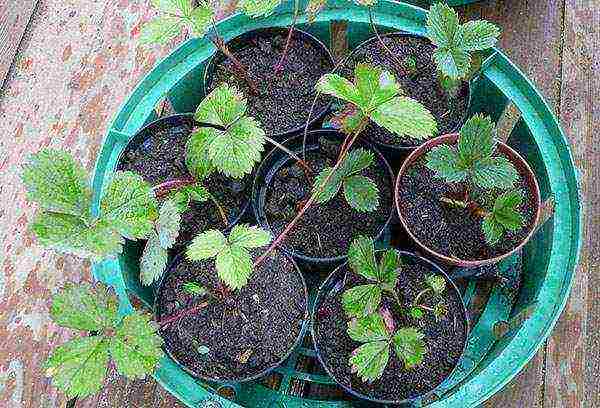
Planting strawberry bushes
Not every variety is suitable for growing in winter in a greenhouse. The best results are obtained from the Dutch strawberry, specially bred for obtaining rich harvests indoors. If you could not get planting material of this type, you can try any remontant variety.
Experts recommend using strawberries of the following varieties for growing in a greenhouse:
- Mount Everest;
- Marmalade;
- Zenga Zengana;
- Elsanta;
- Yellow miracle.
Planting material can be purchased at the nursery or collected at your dacha. In the fall, the antennae are planted in a separate bed. To obtain seedlings, a strong bush is taken, which in the first year is not allowed to develop buds and whiskers. The next summer, the plant will release many shoots, they need to be rooted and left in the open field until frost. In the fall, the bushes are dug up, the green part is cut off, and the roots are stored in the refrigerator. There is no need to care for the seedlings, but it should be checked from time to time to ensure that they do not rot. This method allows you to get a lot of material for planting without cost and complex work.
In the greenhouse, the roots are planted in boxes or polyethylene bags. The second method is more convenient: containers with soil are easier to carry, store and place on racks. For planting, holes are cut through 25 cm from each other and a bush is placed there.
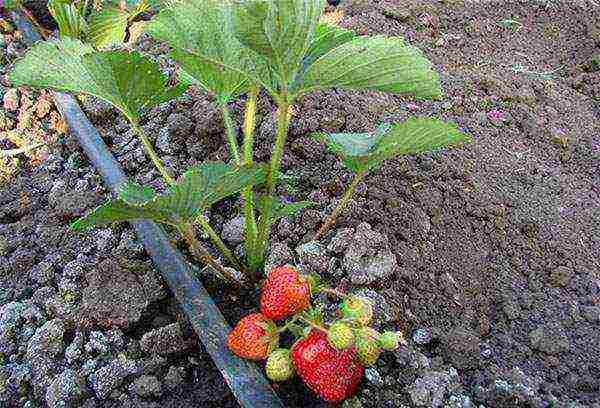
Winter planting care
To grow strawberries in extreme conditions all year round, you need to provide them with sufficient nutrients. The soil must contain both organic matter and minerals. The easiest way is to buy a special mixture for feeding strawberries. If you can't find one, add compost or rotted manure to the ground. Top dressing is carried out 2 times a month.
For fertilization, use a composition of the following components:
- potash preparations;
- phosphorus fertilizers;
- urea.
For fruiting all year round, you need the correct temperature and humidity regime. In the open field, flower buds begin to wake up in cool weather. Before the berries appear, the temperature of the soil and air gradually rises, and the harvest takes place on hot days. Plants in the greenhouse in winter need to create similar conditions, then their development will go right. A good heating system will help to create a suitable temperature regime in each period:
- when landing - +10 ⁰С;
- by the time of flowering, the temperature should be gradually raised to +20 ⁰С;
- for fruit ripening it is best of all +24 ⁰С.
It is also necessary to monitor the humidity of the air. Optimal values:
- when landing - 80%;
- after 20 days - 75%;
- during the flowering period - 70%.
The main care is to properly moisturize the soil. For watering, it is better to use a drip irrigation system. The soil must be constantly evenly moist, when watering with a watering can or from a hose, this result cannot be achieved.It is advisable to mulch the surface of the soil with sawdust, this method normalizes soil moisture and prevents the formation of a crust.
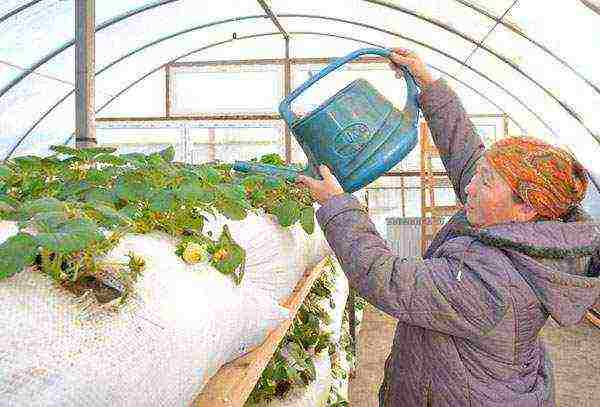
Dutch technology
When growing strawberries using Dutch technology, the crop can be harvested all year round without interruption. It should be borne in mind that even remontant varieties cannot grow and bear fruit constantly, plants also need rest. Prepare enough seedlings and place them in the refrigerator to allow the strawberries to rest. Bushes are planted every 2 months. This method works for both regular and repair strawberries.
Since at different periods of development, plants need special care and their own temperature and humidity values, it is advisable to divide the greenhouse into several compartments. You can adjust the parameters by airing, but it is better to purchase special equipment. There is also a simpler option: new seedlings are placed near the door, where it is cool, and as the bushes develop, they are moved to warmer corners.
For the convenience of work, the cultivation of strawberries in polyethylene bags is practiced. Take the required number of antennae and plant them in pre-cut bags. The bags can be placed horizontally, in one or more tiers. With this method, you need to properly install the lamps so that the upper plantings do not obscure the plants on the lower rack. If you set the film sleeves vertically, you can grow many more bushes in a small area, which will supply you with vitamins all year round.
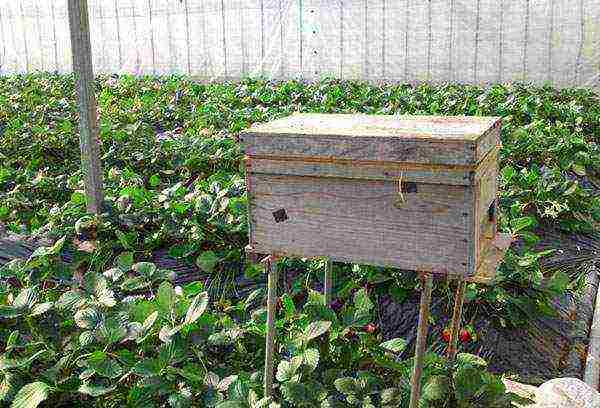
Secrets of the winter harvest
Growing strawberries indoors is different from growing berry bushes in the garden. You will have to tune in not only to high material costs, but also to hard work. It will be a shame if lack of time or improper care kills the plants, and all the work turns out to be done in vain. Over time, you will find your own method of growing winter strawberries. To get started, a few simple rules will help you improve your yields, and you will feast on fresh strawberries all year round.
The greenhouse must be ventilated periodically. In the stagnant air, fungal spores begin to develop, and the strawberries get sick. The main problem is gray rot. If you are going to treat plants with fungicides, remember that you can use the preparations only until the petals have crumbled.
It is very difficult to choose a variety that will be ideal. You will have to experiment with different types of strawberries to find the best one for your situation.
When purchasing seedlings, pay attention to the following characteristics:
- zoned variety;
- self-pollination;
- frost resistance;
- duration of fruiting;
- low requirements for the duration of daylight hours.
Even self-pollinated varieties do not always bear fruit well without insects. In a greenhouse, plants should be pollinated. There are recommendations to place the hive indoors, as much as possible - you can check. It is safer to transfer pollen by hand. The method is simple: take a brush and run the hairs over all the flowers twice a day in low humidity.
Advice
Use household appliances to make pollination easier. Take a fan or hair dryer on no heat and blow off the plants.
Be sure to arrange for the ability to adjust the temperature. Growing strawberries in a greenhouse should take place under different thermal conditions. If you put young bushes immediately in a warm place, they will begin to actively develop leaves, and there will be little strength left for the formation of flowers and fruits.
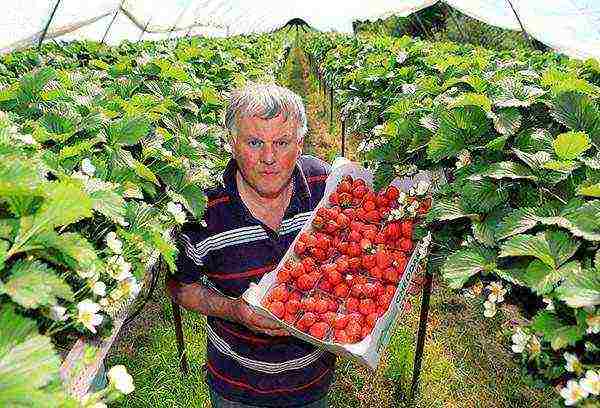
Conclusion
To harvest fresh berries all year round, you need to invest a lot of money. The costs can pay off: some summer residents have set up a solid business selling strawberries in the winter. Before deciding on such a job, think about where you will put the crop.It makes no sense to build a capital greenhouse, buy expensive equipment and provide plants with complex care for the sake of a mug of berries a day. The production needs to be productive - more than the needs of the family, and you need to think about ways to market the perishable fruit.
If you decide to do an unusual thing, decide which method is better: growing strawberries using Dutch technology or arranging an ordinary garden bed in a greenhouse. Reviews are the most controversial, since each owner has its own conditions: climate, size of the greenhouse, material capabilities. You can only decide what is right for you by experience.
Do not be afraid of difficulties. The first time will be difficult, but gradually the work will improve, the strawberries will begin to yield. Soon you will have your own secrets and tricks for obtaining berries in a closed field. Do not hide your experience, share with friends and acquaintances, let vitamin products appear on any table. Don't be afraid of the competition, there are never too many strawberries.
Strawberries are a tasty and healthy berry so loved by many, but the harvest season is limited to two to three weeks late May - early June. A greenhouse for growing strawberries will allow you to pick berries at any time. How to grow strawberries in a greenhouse and harvest all year round? This requires not only the right greenhouse, but also a whole range of measures from soil preparation to pollination and watering the berries.
Greenhouse soil preparation
In the greenhouse, beds and paths are formed for movement. The beds should be no wider than 1 meter for easy care of the bushes. The optimal order of laying the soil in the greenhouse: 5 cm of crushed stone, 10 cm of sand, 7-8 cm of soil. Sand and gravel are needed to create a drainage layer so that moisture remains in the soil for as long as possible and feeds the strawberry root system.
Strawberry beds in the greenhouse
When choosing the type of soil for laying in a greenhouse, you can give preference to turf or peat. They will need to be loosened with sawdust. If this is not possible, you can use the fertile land from the site.
Important! It is not recommended to use the soil on which cabbage or potatoes were previously grown. The ideal predecessor is cereals.
Before planting, the land will need to be fertilized. To do this, you can use ready-made complex mixtures of urea, potassium and superphosphate, as well as compost, manure and mineral fertilizers. Ammonium nitrate is often used as a top dressing. Since strawberries can absorb the chemicals in the top dressing, it is best to give preference to organic fertilizers.
Dutch way of planting strawberries in greenhouses
greenhouse
You can increase the yield and plant more bushes in the greenhouse using the so-called Dutch planting method. It involves the installation of soil pots in several tiers. Thus, more than 50 bushes will fit on one meter of land, and not 8-10 as when planting only in the ground. It is convenient to take care of the bushes planted in this way - strawberries will not get dirty with earth and are easier to pick. In addition, the pots are located above ground level, which means they receive more light and heat, they are not afraid of frost, since all the warm air rises up.
An alternative to the Dutch method is planting strawberries on shelves in plastic bags. In the bags filled with soil with fertilizer, a hole is made into which the seedling is planted. This is a very convenient method, but it has certain drawbacks, the main one of which is the difficulty of high-quality irrigation.
Formation of seedlings
A strawberry seedling is a tendril sprouting from a mother bush. When forming a mustache, you need to follow certain rules in order to get good planting material:
- no more than two mustaches should be left on one bush;
- the shoots forming from the daughter mustache must be cut off, otherwise they will take away its strength and the seedling will not form well;
- after 2-3 weeks, the root begins to form at the mustache, during this period it is necessary to provide abundant watering and dig it in;
- when the mustache has gone into strength, it is required to cut off the stem that connects it to the mother bush.
Strawberry bush
For planting, the most formed seedlings with a developed root system are selected. In the greenhouse, a place can be set aside for the temporary planting of bushes, which, after the formation of the root, will need to be transplanted.
When choosing varieties for planting in a greenhouse, you should pay attention to remontant ones, which give several harvests per year. The most popular of them are: Queen Elizabeth, Brighton, F1 Diva, Albion. They are distinguished by large berries, increased productivity and are quite easy to care for. You can get a good harvest when planting such varieties in a greenhouse: Moscow delicacy, Lyubava, Flora, Miracle Likhonosov, Temptation.
Planting seedlings
Any plants react sharply to the length of daylight hours. Therefore, it is necessary to plant strawberries in spring (late February-early March) or in autumn (late October-early November). Some experts recommend planting seedlings in winter, but daylight hours for full development during this period will not be enough, due to which the yield may subsequently decrease.
If the greenhouse is heated, it is necessary to strictly control the air temperature. During the disembarkation period and over the next few days, it is better to maintain + 25 ° С, after which you can gradually lower it and stop at + 15 ° С. If the greenhouse is not heated, it is best to disembark as early as possible in October. Young seedlings must have time to take root before the cold weather in order to endure frosts without loss.
How to properly plant strawberry bushes
Transplanting seedlings is done with a knife or a special spatula, which you need to carefully dig in the bush so as not to damage the root system, and remove it together with the root from the ground. It is not necessary to shake off the soil from the root.
Important! It is better to transplant seedlings with soil on the rhizome, so they will quickly take over and go into effect.
It is necessary to plant strawberry sockets so that the next bush is at least 20 cm. The pits should be deep enough (about 10 cm) so that the water lingers near the bush during watering, and does not immediately go into the ground.
Pollination of strawberries in a greenhouse
To obtain high yields, strawberry flowers need to be pollinated for berry ovary. Indoors, this is very problematic. There are several options for greenhouse pollination. First, good ventilation can be provided. To do this, during the flowering period, open windows from two opposite sides for several hours on days when it is dry outside and the wind is blowing medium strength. This method is not permissible for greenhouses made of film, since the wind can destroy the structure of the greenhouse. In this case, you can install several fans in different corners of the greenhouse and turn them on periodically. A light breeze will carry the pollen and pollinate the flowers.
Artificial pollination of strawberries
Another way is to create a shower. It is carried out using irrigation systems, which must spray the plants from above. The disadvantage of this option is the low yield, since almost half of the pollen will simply be washed off with water.
The most optimal, but difficult to implement, pollination method is to introduce insects in the greenhouse. This is most often done by installing a hive in a greenhouse.
Care for strawberries in the greenhouse
Each strawberry variety requires a certain amount of care. It may differ slightly in relation to the conditions of maintaining the temperature or humidity. But in general, the rules and recommendations for care look like this:
Strawberry bushes require careful maintenance
- feed the bushes with superphosphate, potash fertilizers or manure twice a month;
- ensure uniform periodic watering. Often, drip irrigation is installed in the greenhouse, which is optimal for growing strawberries;
- maintain the temperature regime and air humidity, in accordance with the recommendations for the selected variety;
- provide sufficient light in winter;
- periodically ventilate the greenhouse to ensure the normalization of air humidity and reduce the risk of disease.
The main diseases of strawberries
Despite the limited access of pests, strawberries are susceptible to many diseases. Most of them occur due to high humidity and abundant watering, for example, white or brown spot. The first signs of their occurrence: the appearance of white spots on the leaves or their darkening along the edges to a brown hue. Infected bushes can be treated with copper sulfate or Euparen. Falcon can also be used for white spot and Metaxylene for brown spot.
Important! The best preventive measure to prevent many diseases of strawberries growing in a greenhouse is periodic ventilation.
At high air humidity, white rot or powdery mildew can form. Good airing of the greenhouse can neutralize most of the spores of these bacteria. Copper sulfate or a soap solution will help with powdery mildew.
Common diseases of strawberries
The most common root disease is late blight, which affects the root system and the plant dies. All diseased bushes must be removed so that the infection does not progress. Slowly developing seedlings can be infected with late blight, it is better to process them with Quadrix.
Growing strawberries in a greenhouse: video
Until recently, the cultivation of strawberries in winter was only possible for greenhouse complexes with industrial capacities. Now, planting strawberries in a greenhouse will surprise no one - modern varieties and technologies allow anyone to do this.
Of course, year-round cultivation of strawberries requires financial investment, labor and knowledge, but with enough effort it can pay off. In addition, even if you are not going to make a business out of growing strawberries in a greenhouse, it can become an interesting hobby.
Equipment for growing strawberries
The most expensive thing in growing strawberries is building a greenhouse and its equipment. You cannot do with an ordinary wooden greenhouse with a film cover - it, of course, is able to accelerate the ripening of berries in summer, but it will not survive the winter.
Therefore, usually for winter cultivation of strawberries, a glass or polycarbonate greenhouse is installed on a wooden or metal frame. The thickness of the polycarbonate must be at least 16 mm, and the base is strong enough not to fall through under the load of snow. For residents of the northern regions and those who want to significantly save on heating, a thermos greenhouse partially submerged in the ground can be an excellent option.
In addition to the greenhouse itself, you will need:
- phyto-lamps or fluorescent lamps capable of providing plantings with 10-14 hour daylight hours;
- drip irrigation system;
- a heating system that maintains a uniform temperature in the greenhouse;
- fans that provide air movement and uniform heating at different heights;
- thermometer and hygrometer (temperature and humidity sensor);
- racks, pots and boxes (for tiered planting).
Greenhouse strawberry varieties
Not every variety is suitable for growing strawberries for sale or for your own needs in the cold season. Only varieties with a certain set of qualities will give a large harvest:
- self-pollinating (setting fruit without insect involvement), becauseputting a hive with bees in a winter greenhouse is quite difficult and too expensive, and it is irrational to pollinate thousands of inflorescences yourself.
- neutral day varieties (they bear fruit continuously, tying fruit buds every 5-6 weeks).
- with berries that are stable, transportable and leveled in size.
Many varieties meet these criteria, but most of them are not of Russian selection, so you will also have to spend money on planting material. If you want a guaranteed high result, choose: Albion, Pineapple, Arapaho, Brighton, Mount Everest, Darselect, Elizabeth II, Temptation, Capri, Crown, Linosa, Mahern, Moscow delicacy, Ozark Beauty, Red Rich, Sakhalin, Tribute, Truffau Producer, Tristar, Elsinore, Everest and others.
It is important to remember that strawberry seedlings must be prepared and tested before they are planted in the greenhouse. Purchased seedlings in the summer need to be planted in open ground, check their fruiting and varietal qualities, and then collect and plant the "mustache" that they will give in the second half of summer.
These "mustaches" are actively watered and fed, helping them to form a developed root system, and at the end of October (before the onset of frost) they are transplanted into pots with a diameter of 8-10 cm, the leaves are removed and put into storage (cellar) with a temperature from 0 to -2 ° C. Only after a dormant period, which, depending on the variety, can last from several weeks to 9 months, are the bushes ready for planting in the greenhouse.
If you do not want to spend the whole season preparing planting material, you can buy frigo strawberry seedlings in the nursery, which has already passed all the necessary stages of preparation.
Methods for growing strawberries in a greenhouse
The yield and payback rate of the greenhouse depend on which method of planting strawberries you choose. On average, up to 60 kg of berries can be harvested from 1 square meter of strawberry plantings per year, but this figure is reached by experienced farmers, and beginners in the first couple of years can count on only a 50% result.
Growing strawberries in the ground
The easiest and most common way is to plant strawberries in a greenhouse directly into the ground (regular or high ridges). Of course, this limits the usable area of the greenhouse to one level, but it allows you to spend a minimum of time on maintenance.
When planting in the ground, the bushes are planted at a distance of 20 × 20 cm, and the bed is covered with spunbond or mulch. This allows you to protect plants from pests, the earth from drying out, and yourself from regular weeding.
Growing strawberries using Dutch technology
Practical Dutch technology allows you to get the most out of even a small greenhouse. On it, strawberry bushes are planted in bags with nutritious soil and are replaced after each fruiting.
This technology gives a significant increase in the yield, but it is rather difficult to implement it - the plantings need racks, a complex branched system of drip irrigation and fertilization, as well as a separate plantation for growing seedlings.
Growing strawberries in horizontal PVC pipes
The method of growing in PVC pipes is visually similar to the previous method. The pipes themselves are both a support on which the bushes are located, and a container for soil, and do not allow water to pass through, which means that you can start watering directly over them.
For the construction, PVC pipes of two sizes are needed: with a diameter of 100-150 mm and thinner, with a diameter of 20-30 mm, but longer. In thick pipes, using a drill with a wide nozzle or a grinder, cut holes up to 5 cm in diameter at a distance of 15 cm from each other. Small holes are drilled in thin pipes, then the pipe is wrapped with geotextile or agrofiber and fixed with wire.
Expanded clay is poured at the bottom of thick pipes for drainage, then thin pipes are inserted through which water and fertilizers will be supplied, and then the rest of the soil is covered with fertile soil, and seedlings are planted in the holes from above.
Irrigation pipes are connected to an automated irrigation system or a large container of water raised to the very ceiling of the greenhouse. Wide PVC pipes on both sides are closed with plugs so that the water does not wash out the soil.
Each adult strawberry bush needs 3-5 liters of soil.
For detailed instructions on the construction of such structures, planting seedlings in them, caring for plants in summer and winter, see our article Growing strawberries in PVC pipes - instructions for beginners with a video.
Growing strawberries in pots and containers
For the smallest greenhouses, for example, half-slope greenhouses attached to one of the walls of the house, or winter gardens, growing strawberries in pots is suitable. This option is not suitable for business, but it can significantly diversify your family's diet in winter and cold seasons.
Watering, supplementary lighting and feeding remain the same as in large greenhouses, however, a small number of bushes will keep the time for strawberry care to a minimum.
Care for strawberries in the greenhouse
Strawberries in a greenhouse in winter require special care and close, almost every minute attention. After all, it is worth once overcooling or undernourishing the plants, and the entire plantation can lose the crop or die, and all the work and investments will be in vain.
How to prepare a greenhouse for planting strawberries
After the construction and technical equipment of the greenhouse is completed, it's time to start preparing the soil. If growing berries is a business for you, and you want to know exactly how many strawberry bushes to plant in the greenhouse so that it is profitable to grow it, then you should not save on the soil. Use coconut fiber, rock wool, or a ready-made substrate.
If you grow berries exclusively for your own needs, then you can prepare the soil yourself. To do this, spill the garden soil with a weak solution of potassium permanganate, add into it a bucket of rotted manure and low-lying peat, half a bucket of coarse-grained river sand, 70 g of superphosphate, 2 glasses of ash and 20 g of carbamide per 1 sq. Mix the resulting soil thoroughly, remove all stones, plant debris, larvae and insect eggs.
Conditions for growing strawberries in a year-round greenhouse
How soon the first flowers and ovaries will appear on the strawberries depends on the growing conditions of the bushes. Typically, each variety requires specific planting and growing conditions. But there are also rules common to all that guarantee a good harvest.
- During planting of seedlings, the temperature in the greenhouse should be 10-12 ° C, during the growth of greenery, it is raised to 20 ° C, and before flowering up to 24 ° C.
- The optimum humidity in the greenhouse is about 85% during planting, and not higher than 70% when strawberries are blooming.
- When watering, water should not get on the flowers and leaves, so drip irrigation of strawberries is necessary.
- In addition to windows for ventilation, which can be opened in summer and at positive temperatures, a forced ventilation system should be thought out for the winter.
- Strawberries need at least 8 hours of daylight. Under such conditions, it will bloom two weeks after planting, and the berries will tie in a month and a half. If you double the daylight hours, then the first flowers will appear in 10 days, and the berries - in 35-37 days. It is necessary to light up strawberries continuously only on cloudy days, the rest of the time you can do it in the early morning (before the sun appears) and after its sunset.
- Strawberries need to be fed every 14 days. To do this, you can take ready-made nutrient solutions or prepare a mixture of 40 g of ammonium nitrate, 40 g of superphosphate, 10 g of potassium salt per bucket of water.
Treatment of strawberries from diseases and pests
In warm and humid greenhouse conditions, not only strawberries develop well, but also pests and diseases affected by such unexpected conditions for winter. They will attack the winter greenhouse with triple strength, so it is better not to forget about prevention, so as not to lose such expensive berries.
All diseases typical for strawberries on the street are also found in its greenhouse relatives, and the treatment is no different.
To avoid these kinds of problems, follow a few simple rules:
- plant only healthy seedlings;
- do not overdo it with nitrogen fertilizers and do not skip potassium-phosphorus fertilizers;
- remove diseased, dried or broken leaves and stems in a timely manner;
- donate diseased bushes if it was not possible to save them when the first signs of the disease appear;
- before the ovaries appear, treat the bushes with Fitosporin, Alirin or Glyocladin in order to prevent diseases.
Now that you know how difficult it is to grow strawberries in a greenhouse all year round, you will understand why these berries are so expensive in winter and they are rarely found on the shelves.
